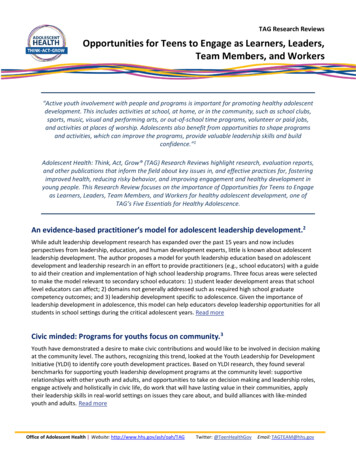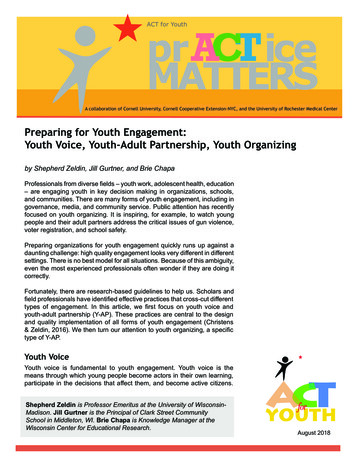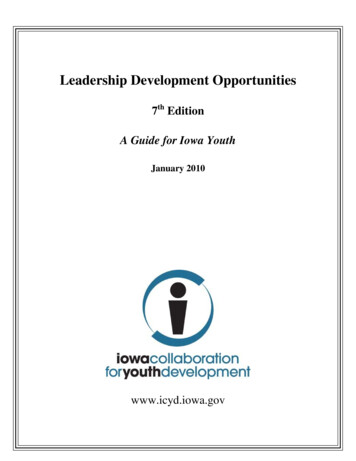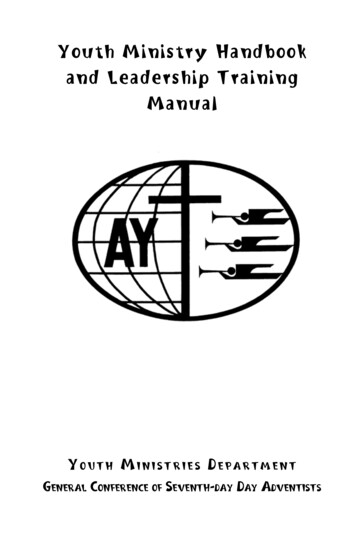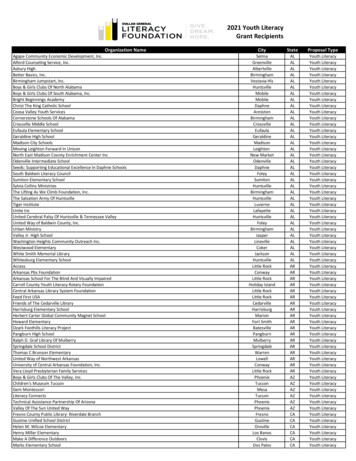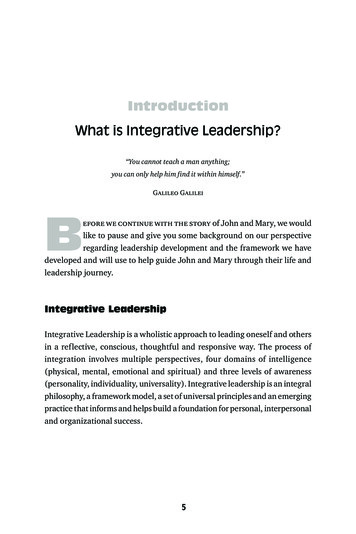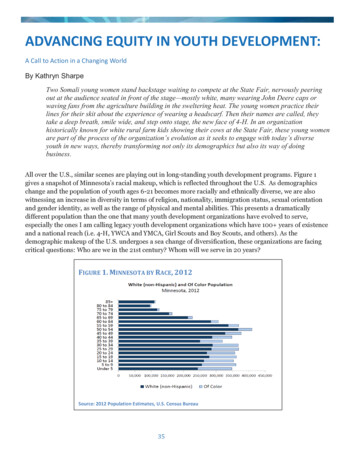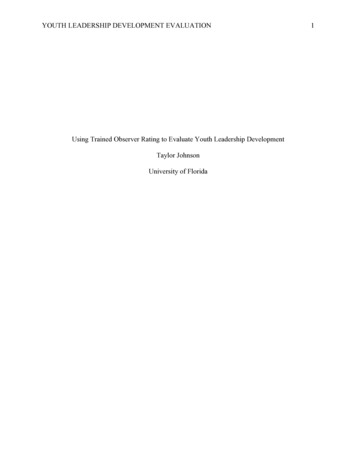
Transcription
YOUTH LEADERSHIP DEVELOPMENT EVALUATIONUsing Trained Observer Rating to Evaluate Youth Leadership DevelopmentTaylor JohnsonUniversity of Florida1
YOUTH LEADERSHIP DEVELOPMENT EVALUATION2Table of ContentsSituation Statement . 3Definition of Terms .4Literature Review .4Theoretical Framework 5Instrument 7Instrument Utilization .7Pilot Test . .8Recommendations . .10Conclusion .12References . 14
YOUTH LEADERSHIP DEVELOPMENT EVALUATION3Situation StatementYouth organizations play an important role for youth participants to become engagedadult members of society by providing meaningful development opportunities. If youthleadership skills are not nurtured, communities run the risk of not having competent memberswho are familiar with the local culture to step into important roles for prosperity. Youthprograms intend to stand in this gap to educate their youth about leadership and transferrableskills while helping them gain knowledge of professional and social opportunities.Initially, an evaluation instrument was designed for Polk Vision’s Youth Leadership PolkProgram. This particular program did not have the capacity for enough trained volunteers toobserve the students’ progress. Furthermore, the program did not have a consistent approach todeveloping these youth leadership skills. Therefore, the evaluation instrument could not beutilized for their program. Since this instrument can be implemented in a variety of preparedprograms, the 4-H Club in Hardee County adopted the evaluation instrument as a part of theirprogramming for 2019 school year.The Hardee County 4-H Special Interest Club (SPIN Club) is a recruitment effort in localschools to create awareness and interest in the youth program at their community extensionoffice. In a pilot study, Jose Zayas, the Hardee County 4-H Agent, implemented the tool withthis small group of students to see if they increased in the five skills while testing the relevancyof the tool in youth programs.The essential skills to be measured in the project are creativity, critical thinking,collaboration, communication, and conflict management. Mastering these competenciesdevelops employability and increases leadership capacity. The details of the curriculum or
YOUTH LEADERSHIP DEVELOPMENT EVALUATION4activities within a youth program are not necessary to developing these skills. Any program canseek to foster an environment for growth in these areas no matter their curriculum focus.Definition of TermsThe definitions of the five skills that will be observed have been developed based onJunior Achievement curriculum. However, the programs utilizing the tool are not required toimplement this curriculum. These definitions are important to understand the administration ofthe evaluation tools and comprehending the overall goals of the curriculum.1. Creativity – student shares their original or unique ideas that are implemented toeffectively meet the goals of the activity.2. Critical Thinking – student demonstrates understanding and deeper thought by askingreflective questions and evaluating ideas of their teammates.3. Collaboration – student cooperates with their teammates while encouraging participationfrom all teammates to meet the goals of the activity.4. Communication – student effectively shares their thoughts, questions, and ideas withteammates.5. Conflict Management – student handles conflict fairly, positively, and calmly thatinvolves themselves and/or teammates.Literature ReviewAccording to research, community-based organizations (CBO) can have a significantimpact on youth development of skills and positive attitudes (McLaughlin, 2000). Theseorganizations provide their constituents with meaningful experiences in order to understand theirinterests and how to better contribute to their community with those interests (McLaughlin,
YOUTH LEADERSHIP DEVELOPMENT EVALUATION52000). Students who participated in these CBOs were more likely to express hopefulness,personal value, and self-initiative (McLaughlin, 2000).In a follow-up to this original study, majority of students involved in the CBOs observedwere on positive pathways as a professional, parent, and community member (McLaughlin,2000). Murphy and Johnson take it a step further saying that if there is an understanding of theskills and features of identity in youth leadership, the needs for adult leadership development arealso better understood (Murphy & Johnson, 2011). Students in programs with a priority of youthdevelopment have the accessibility to this growth and achievement. The purpose of thisevaluation is to ensure that youth programs are implementing the most appropriate tools tosupport leadership capacity. If there are fitting evaluation tools, then programs are betterpositioned to improve their effectiveness.Theoretical FrameworkA Carnegie Foundation study that examined 120 youth-based organizations throughoutthe United States over a ten-year period. The results of this examination determined that therewas a weighty disconnect between the youth leadership educational efforts and the actualexperiences and needs of youth (Klau, 2006). From this lack of clarity, the Heifetz Frameworkwas developed (Klau, 2006). The model of adaptive leadership clarifies the definition ofleadership and creates relevancy to youth education (Klau, 2006).A priority distinction in the Heifetz model of adaptive leadership is between authorityand leadership as youth can have access to these leadership skills without the access to authority(Klau, 2006). The three pedagogies in Heifetz leadership education methodology are related toaspects of Junior Achievement curriculum. The first pedagogy is Case-in-point Learning toencourage students to discuss dynamics of the group in which the students are involved (Klau,
YOUTH LEADERSHIP DEVELOPMENT EVALUATION62006). The second pedagogy is Below-the-neck learning which provides students theopportunity to have hands-on experience leading in activity settings (Klau, 2006). Reflectivepractice is the final pedagogy in this model for which YLP would have the ability to do aftereach lesson (Klau, 2006).Each of these pedagogies can be reflected in Junior Achievement curriculum and theobservable leadership skills in this study. The behaviors listed in the evaluation tool can be usedto measure the success of this framework for youth leadership education.The pedagogies and related C skills: Case-in-point Learning: collaboration, communication, conflict management Below-the-neck: creativity, collaboration, critical thinking, communication Reflective practice: creativity, collaboration, critical thinkingThe evaluation tool that employs direct observation was selected since this program willbe focusing on youth subjects. Self-reporting in youth can be vulnerable to discrepancies(Razavi, 2001). If the independent and dependent variables are based on self-report, the validityof the experiment becomes susceptible to potential systematic response distortions, methodvariance, and the psychometric properties of questionnaire scales (Razavi, 2001). Theorganizations in the scope of this project were either using self-reporting surveys or noevaluation program at all.This is believed to be a trend in many youth organizations due to the lack of research ofeffective practices or recommendations for evaluation tools. If youth programs are notimplementing appropriate evaluation programs, they are missing their potential to improve theirprograms and to effectively impact their participants. Particularly with leadership development,longitudinal research beginning with youth would provide a deeper understanding of the
YOUTH LEADERSHIP DEVELOPMENT EVALUATION7dynamic nature as a whole (Murphy & Johnson, 2011). The intention of this project is to fill thisgap with an observational evaluation tool to support youth organizations to strengthen theirprogramming and their participants. Furthermore, it is anticipated that these participants becomemore effective leaders and more active community members.InstrumentThe Five Cs of Youth LeadershipInstrument UtilizationBased on observed behavior, a student will be scored with a 1, 2, 3, or 4. The numberscores are associated with the definitions that are “poor,” “needs improvement,” “developing,”and advanced” respectively. The scores for each student from the beginning and ending of theprogram will be compared to measure change.Each evaluator expected to utilize the instrument will need to participate in a toolorientation. It is assumed that the evaluators to have experience with youth through education
YOUTH LEADERSHIP DEVELOPMENT EVALUATION8background or previous volunteer activities. The definitions of the skills will be explained anddiscussed to ensure each evaluator is on the same page in regards to what behaviors warrantwhich score. It is imperative for program leadership to create a culture that values evaluation sothe volunteers and staff take their role in it seriously.Beyond familiarity with youth development, the purpose of the training is for evaluatorsto have a clear understanding of the skills the students are expected to develop over the course ofthe program. They will implement the pre- and post-tests by observing the students in groupsettings using consistent expectations of how each skill is defined. The scores provided by theevaluator will not be shown to students to ensure the evaluators the freedom to record honestlyand fairly.As aforementioned, the tool can be used within any curriculum. However, in order toobserve the students appropriately there needs to be a group activity observed by the evaluatorsat the beginning and ending of the period of learning. The instrument is not designed forindividualized work as most of the skills the skills require peer interaction. There is minimalrestriction on what the group activity needs to be as long as they evaluator can observeinteraction of the 5 Cs.Pilot TestThe population consisted of the eight student participants in the Hardee County 4-H SPINClub. The sample was five randomly selected learners. The students participated in thecurriculum once a week for six weeks. In week one, the students participated in a group activityduring which the 5 Cs can be observed. In week six, the same students were observed doinganother group activity. These activities were relevant to the the content the students werelearning and included interaction with their peers through discussion and applying the content as
YOUTH LEADERSHIP DEVELOPMENT EVALUATION9a team. Specifically, they employed discussion and an experiential learning activity thatreinforced their content while creating observable behaviors.The purpose of the instrument is to see if the students improved their leadership skills inthe duration of the program. The pilot test was to test whether or not the tool can be relevant anduseful in youth programs even if they are not focused on leadership. Through social interactionsand consequences, these skills can be nurtured.The results from week one were compared to the results from week six. It was observedthat each student participant improved their overall score in the cumulative 5Cs of YouthLeadership (Table 1). Each student was given initials only known by the observer. If their scorewas already the highest possible, they remained the same. According to the evaluation, studentsimproved the most in Creativity (Table 2). Collaboration did not increase as all the participantsbegan the program with advanced collaboration skills (Table 2).Table 1Individual Participant Improvement of 5C20151050BBBGLOPre-testLO2Post-testLL
YOUTH LEADERSHIP DEVELOPMENT EVALUATION10Table 2Overall Participant Improvement of Each 5CConflict ManagementCommunicationCollaborationCritical ThinkingCreativity0510Post-Test152025Pre-TestThe intention of the pilot test was to establish a baseline of performance for students andto gauge the appropriateness of this tool for youth programs. After the results of the evaluationwere analyzed, a survey was given to the administrator of the evaluation instrument. Accordingto their experience with the tool, it was very easy to understand and execute. The tool did notdisrupt student participation or core content implementation. Furthermore, based on theirexperience with youth organizations, they believe this tool can be implemented in a variety ofprograms as the skills were relevant to youth leadership. The tool administrator intends torecommend use to their counterparts in their 4H programs, other 4H programs, and other youthrelated organizations.Recommendations for UtilizationIf a community-based youth program wishes to utilize this instrument, there a few factorsthey must take into consideration based on lessons learned in this project. The interestedprogram must determine they have the capacity to utilize the tool. This capacity includes enough
YOUTH LEADERSHIP DEVELOPMENT EVALUATION11people to observe the students while the programming is being implemented in addition to priortraining of the observers to ensure consistent ratings. The program should have a clearlyestablished vision that defines their goals in a way that these tool’s results will help determineeffectiveness.The first program that the instrument was intended for did not have a clear direction orvision for their youth program. Due to their inconsistency, they did not have a testable approach.Therefore, it was necessary to find a different program that had the established program that wasready to be evaluated. If a program does not have defined goals or established program, theymay not be ready for a quantitative evaluation.Due to the instability of an evaluation program in the first attempt, the pilot test was usedto work out kinks of the instrument in a manageable setting before introducing to a larger groupof students. The instrument has gained traction in a smaller group and is ready to be introducedto larger groups.One of the most important aspect of The Five Cs of Youth Leadership Tool is itsadaptability. Based on a program’s goals, administrators can determine how this instrument canbe useful to them. They can look back on how this tool has been used and adjust the tool ifnecessary. For example, if one of the Cs is not fitting to their program they can remove it fromthe evaluation.Furthermore, evaluation needs to be a priority for the program. Leadership within theorganization must foster a culture that values accountability for the long-term success of theprogram. It is understood these organizations are often spread thin and have pressing prioritiesfor implementation. However, evaluation is a worthwhile investment to secure funds and keepan organization on track.
YOUTH LEADERSHIP DEVELOPMENT EVALUATION12For the purposes of training evaluators to use this tool, it would be advantageous to videorecord the Cs in action. That way more evaluators have the ability to see what each skill lookslike in a group activity. Videos would allow for capacity building as the training can be spreadto many organizations. It is important to empower the program administrators with thisinstrument so they feel comfortable to implement it. If they are confident in their abilities to useit, they might be more likely to encourage their organization to adopt it and potentially pass italong to similar organizations.ConclusionYouth organizations are uniquely positioned to improve the quality of life for theirparticipants and improve community development. If they nurture leadership skills in youtheffectively, they make a positive investment in the future of their community. Youth who aremeaningfully engaged in community programs have the opportunity to improve self-esteem,skills, and leadership capacity. Furthermore, youth who were invested in by community basedorganizations tend to set on more positive trajectories and become active leaders in theircommunity.Due to the lasting impact of these organizations, it is imperative to support them to dotheir job well. Which is why this project focused on developing an evaluation instrument to beutilized in organizations who serve youth participants. The Five Cs of Youth Leadership Toolwas designed to be adaptable for a variety of programs to measure their ability to develop theseskills in their participants not dependent on their priorities of curriculum. No matter the contenta program is delivering, the 5Cs are essential to develop for leadership development and futureemployability.
YOUTH LEADERSHIP DEVELOPMENT EVALUATION13The instrument proved to be effective to measure changes in behavior throughobservation. The implementation did not disrupt the learning environment and could be relevantto any youth programs. In order to utilize this tool, evaluation should be a priority of theprogram administration to ensure there is capacity for trained evaluators. Furthermore, aprogram must have a consistent and measurable direction. With these factors, the evaluationinstrument is suitable for youth programs that want to make a lasting impact.Youth leadership development is crucial for continued community improvement. Youthprograms have the ability to propel communities in the right direction. Through observationalevaluation, these programs can inspect their strengths and weaknesses. The better they knowhow to improve the more they can continue to effectively support youth leadership developmentand their community’s prosperity.
YOUTH LEADERSHIP DEVELOPMENT EVALUATIONReferencesKlau, M. (2006). Exploring youth leadership in theory and practice, Leadership Learningthrough Activities, 2006(109), 57-62. https://doi.org/10.1002/yd.155McLaughlin, M. (2000). Community Counts: how youth organizations matter for youthdevelopment. ERIC. Retrieved from: https://eric.ed.gov/?id ED442900Murphy, S. & Johnson, S. (2011). The benefits of a long-lens approach to leader development:Understanding the seeds of leadership. The Leadership Quarterly, 22(3), 04Razavi, T. (2001). Self-report measures: an overview of concerns and limitations ofquestionnaire use in occupational stress research. University of SouthamptionInstitutional Repository. Retrieved from https://eprints.soton.ac.uk/35712/14
programs as the skills were relevant to youth leadership. The tool administrator intends to recommend use to their counterparts in their 4H programs, other 4H programs, and other youth-related organizations. Recommendations for Utilization If a community-based youth program wishes to utilize this instrument, there a few factors
